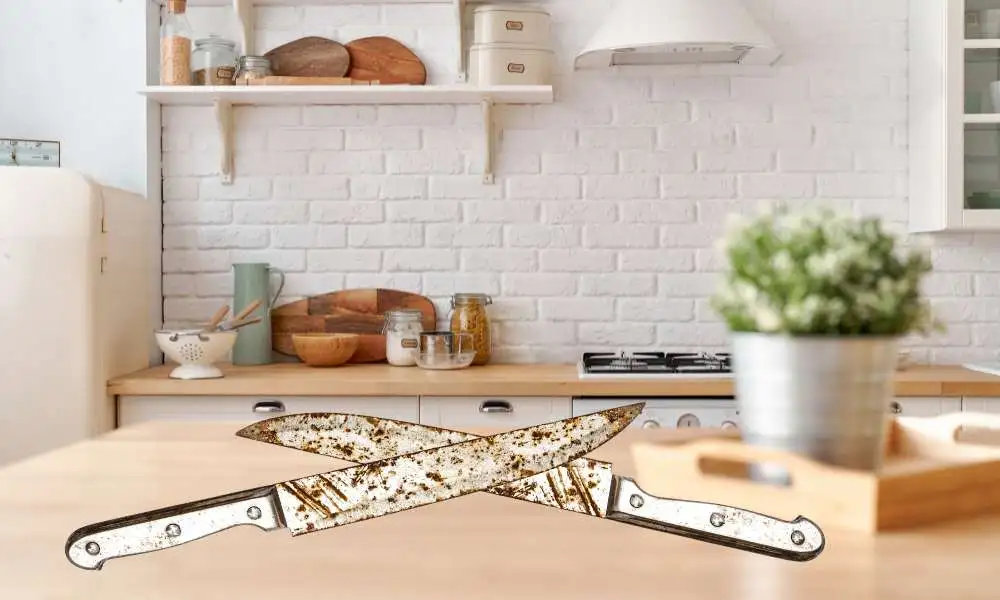Rusting knives can be a real pain to clean. Not only do they take a lot of effort and scrubbing, but the rust can also be hard to remove. Fortunately, there are a few easy steps you can take to clean a rusty knife effectively.
If your kitchen knife is rusty, you can do a few things to clean it up. Many people use a little vinegar and water to clean their kitchen knives, but others use a product such as steel wool or a scotch-Brite pad. It depends on the severity of the decay. Using vinegar and water will work if the decay is just starting and has not taken hold in any other part of the blade.
Rust and Knives
Rust is something that most people associate with old furniture and cars, but it can also be found on kitchen knives. If left unchecked, decay will cause a blade to become brittle and difficult to use. There are several ways to prevent rust from forming on your knives, but the best way to deal with it is usually to get them serviced regularly.
If you do find yourself with rusty knives, there are a few steps you can take to restore them. Start by cleaning the blade off with a mild soap and water solution. Then dry it off thoroughly before coating it with a layer of decay inhibitor. Let the solution sit on the knife for at least 12 hours, and then wipe off any excess. Finally, apply a final coat of decay inhibitor and let it sit for another 24 hours before using your blade.
Common Causes of Rust
Rust is a common problem with knives. There are many different causes of rust, but the most common are water and air. When you get a knife, the water molecules join up with the metal to create decay. The metal can also become rusty when it is exposed to air and moisture. To prevent decay, you should dry your blade after each use and store it in a dry place. You can also apply a protective coating to your blade to keep it from rusting. Read more knife holder kitchen ideas.
Cleaning Supplies Needed
If your kitchen contains a rusty knife, it’s time to get cleaning supplies. Here are the items you’ll need:
- Dish soap
- Hot water
- Scrub pad
- Sponge
- Bucket
Soak the scrub pad in hot water and wring out the excess. Rub it along the blade of the rusty knife. Wipe off any dirt or residue with a damp sponge. Repeat on the other side of the blade. Fill the bucket with warm water and add dish soap. Swish around until the knife is clean.
Steps for Cleaning a Rusty Knife
If you’ve got a rusty knife, here are some steps to help clean it: remove any sharp edges first by carefully grinding them down with a file or sandpaper until they’re almost smooth. use a cleaner that is specifically designed for cleaning decay and corrosion, as dish soap and water mixed together. scrub the blade vigorously with the soapy mixture, then rinse it off and dry it off completely. apply a coat of oil or WD-40 to the blade and let it sit for 24 hours before storing your blade away again.
Prevention of Rust
Rust is one of the most common problems with knives. It can form on blades, sheaths, and other metal parts. Rust can degrade the knife’s cutting ability, appearance, and even safety. Here are some tips to prevent decay: Wipe down your knife after each use with a dry cloth or paper towel. This will remove the accumulated moisture and keep your blade from rusting. Store your dagger in a dry place when it isn’t in use. A cabinet or drawer is ideal but avoid direct sunlight or humidity. Avoid placing your dagger in water, even if the blade is covered by a sheath. That droplet of water can cause corrosion over time. Clean the inside of a gas grill.
Conclusion:
Cleaning a rusty knife is easy with the right tools and know-how. Here are a few tips to get the job done quickly and effectively: use a household cleaner like water, soap, or ammonia; use a wire brush to help remove rust and dirt; use an abrasive cleaning cloth to buff the blade; dry the blade with a soft cloth. Finally, store your knife in a safe place so it doesn’t rust further.

